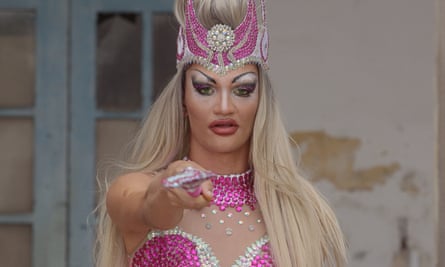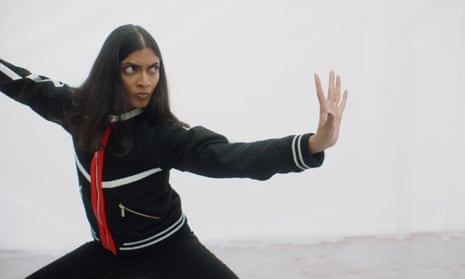Movement-focused film in art galleries doesn’t usually mean cool fight scene choreography or toe-tapping beats. Historical benchmarks – for example 1960s and 70s mavericks such as Bruce Nauman pacing his studio on camera, or the Judson Dance Theater’s studies of dance in daily life – typically have stark aesthetics and cerebral appeal. The exuberant works in the Whitechapel Gallery’s upcoming exhibition Moving Bodies, Moving Images, then, are doing something new. “It’s often very cinematic,” says curator Lydia Yee of films that include dazzling drag artists, human-plant hybrids and girls with superpowers performing stylised martial arts.
One striking example is Hetain Patel’s superhero riff Trinity, in which a young British Indian woman channels ancestral voices to develop special powers: a forgotten means of communication blending kathak dance and kung fu. Co-written with Louise Stern, who is deaf, the project came partly, the Bolton-born Patel says, from feelings of being misunderstood, not least “having grown up being misjudged by my appearance – realising my body speaks in ways I have no control over, like the colour of my skin”.
Moving Bodies … promises to be an exhibition for this moment in other ways, too, including our need for physical expression and togetherness in a world emerging from lockdown. This is especially true of the videos from the artist and choreographer Éric Minh Cuong Castaing’s series Form(s) of Life. The two people with whom he collaborated – former boxer Kamel Messelleka (who has had a stroke) and the dancer Élise Argaud (who has Parkinson’s disease) – usually spend their days being cared for indoors.
Our connection to the natural world is another thread, as with Eglė Budvytytė’s eco-science fiction vision of youths navigating lichen forests and sand dunes as their bodies grow fungi and seem to mutate and meld with trees and stones. “There’s a sense that we are not separate from these environments; they shape us and we them,” says Yee. Place is also central to Alia Farid’s extraordinary piece, At the Time of Ebb, composed from poetic documentation of Iranian fishers’ summer solstice celebrations and shot on the island of Qeshm in the Persian Gulf, a crucial region for the global oil trade. Yet Farid’s camera captures a community seemingly cut off from the modern world in fragments that can seem familiar and strange: masked figures in tall straw hats dance and parade in animal costumes; a young man gives a sinuous dance performance in a cramped pink room – a traditional way of welcoming guests.
Dance becomes a platform for exploring the push and pull between individual identity and wider culture and tradition in the exhibition’s most ebullient work, Bárbara Wagner and Benjamin de Burca’s Faz Que Vai (Set to Go). Working closely with gender-fluid dancers, the artist duo have created portraits of their take on frevo, the carnival dance from the Brazilian city Recife. In what the artists call “forgotten and left out” urban spaces, the performers work magic. As poses are struck, a sequined backside shakes or an umbrella flies into an outstretched hand and the traditionally heteronormative dance is transformed. While the dancers might make frevo their own by mixing in voguing or samba, the artists point out that the dance marks them, too.
“Each generation brings their own knowledge and experience to it,” Wagner and De Burca say. “The beauty of it is that frevo transforms them as much as the other way around.”
Four works from the show…
Hetain Patel’s Trinity (2021), main picture
“The fight language in Trinity was created as a meeting place between martial arts and sign language,” says Hetain Patel, who collaborated with a deaf screenwriter on his film where a young British Indian woman develops powers. “While I’m a fan of kung fu films, I often want them to do more. [In the film] it’s a reawakening of the first human language – a language of empathy, of deep connection between people.”

Alia Farid’s At the Time of the Ebb, 2019
Shot on an island in the Persian Gulf, Alia Farid’s film captures ancient summer solstice festivities that seem outside time, yet there are also unexpected echoes with experiences across the globe. She has said she was interested in “making visible the porosity between lands, identities, cultures”.
after newsletter promotion

Bárbara Wagner & Benjamin de Burca’s Faz Que Vai (Set to Go), 2015
A traditional dance evolves before our eyes in this film’s four performer portraits. “Ryan is a highly regarded traditional frevo dancer from Olinda,” say the artists of this portrait. “And Ryan is also Alice, a drag queen who performs bate cabelo, a dance from that scene in a downtown nightclub. The dancers have, literally, one foot in tradition and one in contemporary pop forms as a means of surviving as artists.”

Éric Minh Cuong Castaing’s Form(s) of Life, 2021
The artist-choreographer Éric Minh Cuong Castaing has described his series of films where dancers aid patients with degenerative diseases to recapture movements from their former life – in this case as a boxer – as “at the crossroads of caregiving and choreography”.
Moving Bodies, Moving Images is at Whitechapel Gallery, London, from 12 October to 8 January.
